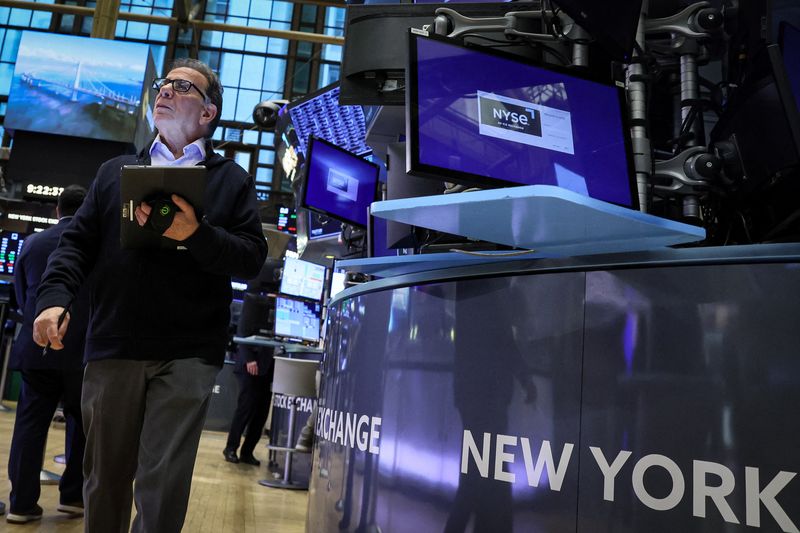By Sinéad Carew and Amruta Khandekar
(Reuters) – Wall Street’s three major stock indexes closed lower on Thursday, with bank stocks creating the biggest drag while investors also worried that Friday’s jobs report could spur more aggressive interest rate hikes from the Federal Reserve.
The S&P 500’s bank index finished down 6.6% after hitting its lowest level since mid-October. Investors fled the sector after tech-industry lender SVB Financial Group launched a share sale to shore up its balance sheet due to declining deposits from startups struggling for funding.
The Nasadaq ended down more than 2% while the benchmark S&P 500 and the Dow lost close to 2%.
Investors were also stressing out before Friday’s U.S. non-farm payrolls report for February with expectations for large wage increases fueling inflation worries. Fed Chair Jerome Powell this week exacerbated concerns about upcoming interest rate hikes aimed at fighting stubbornly high inflation.
Traders were betting that chances of a 50-basis-point rate hike at the Fed’s March meeting were around 60%, according to CME Group’s FedWatch tool, up sharply from a probability of 31% before Powell’s Tuesday and Wednesday appearances in Congress.
“There’s a lot of anticipation around tomorrow’s jobs report. We’re going to get a slew of data in the next week and a half,” said Mona Mahajan, Senior Investment Strategist, Edward Jones, New York, also citing inflation and retail sales reports all due out before the next Fed meeting which ends March 22.
Earlier on Thursday, Labor Department data showed initial claims for state unemployment benefits rose 21,000 to a seasonally adjusted 211,000 for the week ended March 4, compared with economist forecasts for 195,000 claims.
While last week’s increased jobless claims may be “the first sign the labor market may be showing signs of loosening,” Mahajan wants to see “more data points to establish a trend.”
The February non-farm payrolls report is expected to show a payrolls increase of 205,000 after January’s blowout 517,000 figure, which had already led markets to brace for a bigger U.S. rate hike.
Any proof last month’s “gigantic payrolls number wasn’t an anomaly” would serve to “reinforce the market’s anxieties around the Fed’s response to it,” said Mark Luschini, chief investment strategist at Janney Montgomery Scott in Philadelphia.
And with February wage increases expected to rise 4.7% compared with January’s 4.4%, “it feels like its ticking in the wrong direction even if we just meet expectations,” said Mahajan who will be closely watching the wage data.
The Dow Jones Industrial Average fell 543.54 points, or 1.66%, to 32,254.86, the S&P 500 lost 73.69 points, or 1.85%, to 3,918.32 and the Nasdaq Composite dropped 237.65 points, or 2.05%, to 11,338.36.
The biggest drag on the S&P 500 came from the financial sector followed by information technology.
The financials index ended the day down 4%, its deepest one-day percentage loss since June 2020. The S&P bank sub-sector turned negative for the year-to-date on Thursday, last down 4.7% so far for 2023. Thursday was its first full day trading below its 200-day moving average since Jan. 5.
All the S&P’s 11 major industry sectors ended the session lower. Utilities, down 0.8% was the smallest decliner. Consumer staples was the next smallest, down 0.95%, with healthcare down 1%.
With investors already concerned that the Fed could over-tighten and cause a recession and hurt bank lending demand, “there’s an element of ‘sell-first ask questions later’ with regard to contagion risk,” from SVB Financial for banks said Luschini at Janney Montgomery Scott.
SVB closed down 60% at $106.04 after falling at one point by around 63% and hitting its lowest level since August 2016 after the lender slashed its 2023 outlook and launched a share sale to shore up its balance sheet.
Also weighing on the sub-index was Signature Bank, which tumbled 12% to $90.76 after its crypto-bank peer Silvergate Capital Corp disclosed plans to voluntarily liquidate. Silvergate closed down 42% to $2.84.
On the bright side, General Electric Co closed up more than 5% after the industrial conglomerate reiterated its 2023 earnings forecast.
Declining issues outnumbered advancing ones on the NYSE by a 5.12-to-1 ratio; on Nasdaq, a 3.83-to-1 ratio favored decliners.
The S&P 500 posted 5 new 52-week highs and 22 new lows; the Nasdaq Composite recorded 58 new highs and 289 new lows.
On U.S exchanges 11.69 billion shares changed hands compared with the 10.95 billion average for the last 20 sessions.
(Reporting by Sinéad Carew in New York, Amruta Khandekar, Shristi Achar A and Johann M Cherian in Bengaluru, additional reporting by Medha Singh; Editing by Vinay Dwivedi and Sriraj Kalluvila and David Gregorio)
